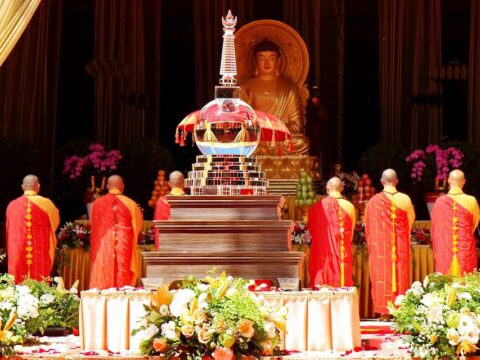What are the 9 principles to effective mantra meditation? To meditate means to think reflectively or to focus the mind on a certain thing. In the yoga tradition, this oftentimes looks like repeating a sound or prayer.
The act of repeating a word or phrase over and over again is called japa. It can be done out loud or silently, and it can be done in the presence of others or alone.
The Sanskrit word “japa” means “to repeat.” But when you do it, you are repeating the sound vibration of that word, which is called the Mantra. Japa can be done to repeat a mantra, to focus, to meditate, or to connect with something or someone.
Video – OM Mantra
Podcast
Here are 3 Ways to do Japa with a Mantra
Repeat It Out Loud
The most common way to repeat a mantra is to say the words out loud. This is often done while walking, or running, or driving. In fact, it was used for meditation in ancient times.
Some people will walk barefoot through the streets, chanting the mantra. They will even walk around their neighborhood or town, repeating the mantra.
While this practice is very common, it can also be dangerous. There are lots of distractions in a big city, and you never know what you might step on. And because you are going through a lot of motion, it can take a lot of energy.
Another reason why it can be dangerous is that people tend to overdo it. They will chant the mantra loudly for hours, until their throats get sore, or until they pass out. This can result in serious health problems, especially if you are not trained in the practice.
If you are thinking about starting a chanting practice, then be careful. Go slowly, and try it out once or twice before continuing.

Repeat It Silent
It is possible to do japa while sitting still. This is a great way to practice when you are sitting in front of your computer. And when you are sitting, your mind is much calmer.
You won’t be distracted by things going on outside, and you won’t be stressed out by deadlines or other obligations.
Silent chanting is also a great way to meditate. When you are doing it, you are focusing on your breathing, and you are trying to release any negative emotions.
One of the best tools to do silent chanting is the rosary. It has 108 beads, and if you repeat the 108 times, you are repeating a single mantra.
There are a lot of variations of the rosary. Some people use a cross for the 108 beads. Others will chant “Hail Mary” instead. There are even mantras that you can repeat, like the mantra for “the Buddha.”
Repeat It Alone
You can also do japa by repeating a mantra when you are alone. This is a great way to connect with something or someone.
When you are doing it alone, you are usually repeating it silently. But there are some mantras that are best done aloud, so you can connect with the sounds and the vibrations.
One of the most popular mantras for this purpose is the mantra of the “Tao.” It is a single syllable, and it can be chanted to connect with everything, including the universe.
Japa can be done to connect with something, to focus, or to help you meditate. Japa can be done to connect with something,

How to Mantra Practice
There are a lot of benefits to practicing mantra, including improving concentration, reducing stress, and boosting the immune system. But the best benefit of mantra practice is that it can lead to real world results.
It can take a long time to become a master of mantra practice. But if you stick with it, you will eventually learn how to do it well. In fact, there are a few mantras that you can memorize today. Once you have mastered those, you can start to add more complex mantras to your practice.
For example, if you want to practice the mantra of forgiveness, you can repeat the mantra “I forgive you.” As long as you keep repeating this mantra, you are practicing forgiveness.
A mantra is like a tool that helps you focus when you’re meditating. It gives your mind a break from everything else going on and allows you to focus on your spiritual practice. Over time, the mantra will help improve your mind and transform your life.
Some principles to effective mantra are very simple to a number of key principles used within effective hypnotic suggestion use:
Make it Realistic and Achievable
If you keep repeating to yourself that you are going to run a 5 hour marathon, when you have only trained for a 2 hour one, it is not going to help you, according to the theory of SMART goals.
They tap into the subtle body and create change. The simplicity, repetition, and conciseness of mantras create change by tapping into the subtle body.
Some people simply string a series of words together that are what they want to feel:
- Stronger
- Faster
- Lighter
- Easier
Think about what you want to achieve, not what you don’t want to happen.
I will elaborate on this later with the strategy I am sharing, but it is important to think positively and proactively. You need to be resourceful.
Use energising words to increase energy. Repeating “I am not tired” suggests fatigue and should be avoided.

You could try developing a few mantras for different types of responses. For example, at the beginning of a race, you might want to stick to your race plan.
But toward the end of a race, you might need more energy and strength to keep going, even if you’re in discomfort.
And during other parts of training or racing, you might have doubts. If you’re feeling pain, those feelings can affect the way you think and believe. So an inspiring mantra could be helpful.
A mantra that you use whenever you like is okay, but if you have laser-focused mantras for specific outcomes, they will provide more specific results that could be more important at particular times.
Mentally Rehearse your Mantra use
You should practice affirming statements when you are feeling good, so that you know the right way to say them. This will make them less vulnerable to being said in a negative way when you are tired or emotional.
The self-hypnosis strategy will be more useful and associated with beneficial sensations.
When you want to create a mantra that will help you to achieve a specific goal, it is important to first attach emotion to the words. Choose a phrase that has a personal meaning to you, and then connect it to a powerful feeling.
For example, if you are trying to lose weight, you might say to yourself, “I am strong and capable of reaching my goal.”
Think of how you would like to feel and use words that describe that feeling. Alternatively, think of an occasion when you felt that way in the past and describe that experience. The words you used to describe that experience can be effective words to use in your mantra.
Make a list of how you want to feel and find words that help elicit those feelings. For example, if you want to feel strong, healthy, and peaceful, you might choose words like “balance”, ” harmony”, and “relaxed”. If you want to feel confident and joyful, you might choose words like “light”, ” assured”, and “vibrant”.

Consider Using Motivational Material
Outhere are many are marvellous quotes us, and some of them can even help us form our mantra meditation. Best is, you create your own mantras in a personallised way, however, there are always expressions and sentiments that we attach meaning and value to that can enhance the effectiveness of a mantra.
Pain is temporary, but pride is forever. I read this in Lance Armstrong’s book, but in light of recent revelations, I’m not sure if it’s still considered cool to praise him. Nevertheless, it’s a mantra I’ve used on many occasions to help me shift my focus from the discomfort of the present and into the joy of the future.
The phrase “leave it all on the road” is very motivatioal and inspiring to me because it was used by someone who I really look up to and who inspires me. I really resonated with this phrase.
A quote from the movie The Shawshank Redemption that I really like is “Get busy livin’ or get busy dyin’.” It goes against some of the main ideas for creating a mantra, but I just wanted to show that a mantra can still motivate you even if it doesn’t fit all the criteria perfectly.
Be Progressive
As you chant, you want your energy to build. You want to get more and more into it as you go. “More and more” and “increasingly” are great words to use for this. They will help you to increase your energy and to get more and more into your chant.
It’s important to use words that will help you increase your energy and get more into your chant as you go. “More and more” and “increasingly” are great words to use for this.
Consider the mantra “running makes me happy.”
This text is reminding the reader to enjoy what they are doing, because it is the point of it all.
The author suggests that saying “happy” is not as powerful as saying “more and more happy.” The author believes that this change can help someone avoid thinking that they have reached the highest level of happiness possible and cannot improve further.
The word “happy” can be improved to make your mantras more powerful. Try using words like “happier and happier,” “more and more happy,” “increasingly happy,” “progressively more happy,” or “more and more appropriately happy.” Choose whatever feels right for you to make your mantra more effective.
Don’t dwell on negative thoughts unless you’re sure they’ll help you in some way.
Words have a very powerful affect on our consciousness. When choosing words for your mantra, keep in mind that they will have a powerful effect on your consciousness.
Choose words that feel good to you and that you believe will promote positive energy.
There are some words that can make you feel bad: Try, can’t, won’t, don’t, shouldn’t, mustn’t, sad, difficult, etc.
The word “try” can make it seem like you are expecting to fail. Using this word can make it seem like you are not confident in what you are doing.
You want to go beyond merely trying into the world of actually doing You should do what you want, and achieve what you want without only trying to do so. You should go past the point of only trying, and into the world of actually doing what you want.
You can find the right solutions and methods for you. As you get more and more used to using mantras or just communicating with yourself more, you can fine tune your use of them.
I do not subscribe to the notion of being unnecessarily sickly-sweet or happy-clappy with yourself if you are not that way inclined. Be as progressive as is useful, comfortable and natural for you.
Now that you understand how important mantras are and how to create effective ones, let’s show you how to use self-hypnosis to get the most out of them while running. This will help you improve your performance and reach your goals.

What are the Signs of Progress?
The continuous chanting of a mantra creates a type of prelude to ajapa japa. With regular meditation practice, the speed of the chant will increase. The person will be able to concentrate more and the repetition of the mantra will happen without much effort.
The mantra will be heard even when other thoughts are occupying the mind. The mantra will be heard very fast and it will seem to stay in the background even when thinking of other things.
If you find yourself thinking about your mantra at unexpected or random times, it’s a sign that you’re progressing towards ajapa japa. The mantra may come to you while you’re doing something mundane, like washing the dishes or driving, without any real effort on your part.
It will stay in your mind for a while before moving on, much like a passing encounter with a friend on the street.
After some time has passed, you will be able to close your eyes and relax to hear the mantra sound whenever you want. Ajapa japa will be a comforting source of peace and tranquility for you.
The Flow of Ajapa Japa
The Flow of Ajapa Japa is the ancient science of self-healing through chanting.
It is based on the belief that the vibration of the voice of the chant is a direct reflection of the life force, which moves through the body and the mind in a specific and precise way. It is said that every living thing has its own vibration.
When that vibration is harmonized with a particular mantra or sound, it enables the life force to flow in that direction. This happens naturally when you speak a mantra, and it becomes a way of life when practiced daily.
This means that a certain mantra or sound will cause the life force to move in that direction, giving rise to a flow. This flow is the energy of the mantra and can be felt by the listener. In fact, the mantra itself can be felt and experienced by the listener. It is the basis for the energy medicine modalities known as Mantra Yoga and Healing Sound Therapy.
When you chant, the voice is an instrument, which vibrates in tune with the sound of the mantra. This allows for the harmonization of the body, mind and soul. By chanting, you become aware of yourself and of the world around you. You develop a relationship with the sound and the mantra.
In order to learn how to chant, we need to be aware of the truth that everything is energy. Everything has a vibration and when that vibration is resonant, it can become conscious. As a result, the energy is directed into a particular path.




